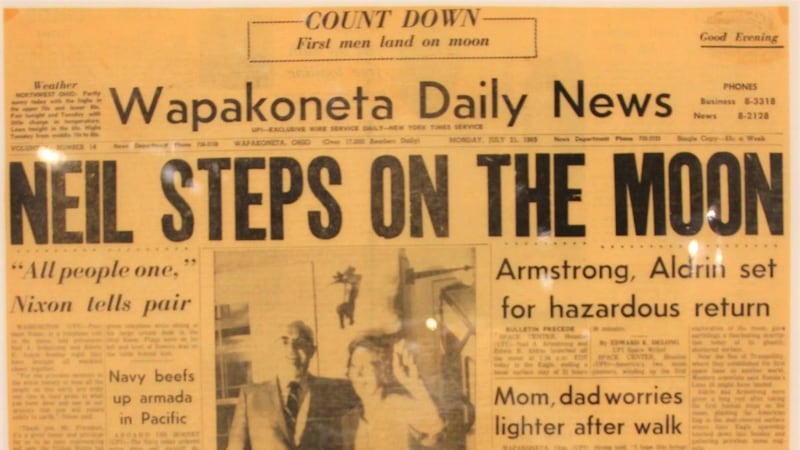On the menu in the Lucky Steer restaurant in Wapakoneta is the moonwalk pancake. On the other side of this small Ohio town, customers at the LaGrande restaurant on South Blackhoof street can sample the Apollo $11 pizza. Around the corner from there in J-Marie's Kitchen, they're selling a cocktail named the full moontini.
The people of Wapakoneta, population 9,872, are celebrating a piece of history that makes this otherwise quaint, sleepy town stand out: this is where astronaut Neil Armstrong grew up, and this week marks 50 years since he became the first man to set foot on the moon.
"We think that for people in the US and around the world, it's important to be able to give some background context of who a hero is – what they did, where they came from," says Greg Myers, Wapakoneta's economic development director. "Few people in history are likely to be remembered like Neil Armstrong."
The son of a homemaking mother and auditor father, Armstrong was born here in 1930. His family moved frequently around the state before eventually settling back down in the western Ohio town in 1944. Armstrong flew his first plane solo aged 16, before he had acquired a licence to drive a car.
At the edge of town, next to Interstate 75 that stretches from Florida in the south all the way north to Canada, lies the Armstrong Air & Space Museum, built into a hill to give it the appearance of a moon station. Along the path to the museum's entrance are small signs bearing surprising stories and facts about space travel and interstellar science, designed to stir visitors' interest in space.
On display inside are pieces of moon rock and various Armstrong memorabilia, such as the first plane he flew, and the landing craft used to return to Earth during the 1966 Gemini 8 mission. That was Armstrong’s first time in space and the first mission to dock together two spacecrafts while in orbit; it ended in near catastrophe when one craft went into a rapid spin that a crew member credited Armstrong with righting.
Famously shy
Despite the fame he earned from being the first man to step on the moon, Armstrong always shied away from public life. His dislike of attention was legendary: at a parade in 1994 held in his hometown to celebrate the 25th anniversary of the moon landing, Armstrong famously failed to show up.
For weeks now moon fever has been sweeping across the US. National Public Radio has broadcast the full audio transmission of the moon landing as it happened shortly before 11pm Eastern Standard Time on July 20th, 1969.

But there’s also much discussion around how America’s role in space travel has changed since Nasa’s glory days of the late 1960s. With more and more countries experimenting in space exploration and travel, Nasa’s once-dominant position as the sole pioneering force in the field is no more.
These days, US astronauts must rely on other countries' rockets to get to and from the International Space Station. And though the field of space exploration involves experiments that seek out failures as much as successes, between the 1990s and 2012 Nasa spent $20 billion (€17.8 billion) on programmes that were ultimately cancelled.
Less than a year before Armstrong died in Cincinnati in 2012, aged 82, he made clear his thoughts on retiring the space shuttle programme, which ended in 2011. "For a country that has invested so much for so long to achieve a leadership position in space exploration and exploitation, this condition is viewed by many as lamentably embarrassing and unacceptable," he told a House of Representatives committee in September 2011. "A lead, however earnestly and expensively won, once lost, is nearly impossible to regain."
As a percentage of federal spending, Nasa’s budget today is a fraction of what it received at the height of the space race in the 1960s.
"Nasa's funding has been a pretty good return on investment because it's been a minuscule percentage of the [overall] tax dollars… Some of the technology transfers from the work on the space programme have been immense," says Dante Centuori, executive director of Wapakoneta's Armstrong Air & Space Museum.
Tourism boon
"Space is expensive, and you're always going to need governments to help promote the privatisation of certain sectors of space exploration. If you look across the world and through history, the large R&D and the large exploration projects were funded by governments. Columbus was funded by a government."
Having raised more than half a million dollars over the past few months to help fund the anniversary celebrations, Wapakoneta is enjoying its moment in the spotlight. The anniversary is also a major economic and tourism boon to the town.
“Every hotel for 40 miles along Interstate 75 is full,” says Myers. “Restaurants and stores in the town will benefit... overall the anniversary and celebrations are worth probably over $2 million in free advertising of our town around the world.”
On the corner of Buchanan and West Benton streets sits Armstrong’s childhood home, a beautifully preserved house decked out with all the buntings and symbols of national pride befitting the astronaut’s legendary status.

Wapakoneta’s celebrations this month include baking the world’s largest “moon pie” – a chocolate and marshmallow biscuit – and has all the trappings of a typical American jamboree including vintage car and tractor shows, a hot-air balloon rally and bed races. Nasa TV will broadcast live from the town on Saturday.
“It’s rare in the US,” says Myers, “that a small community could have that much positive exposure.”










